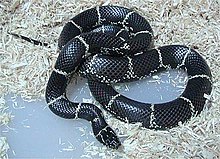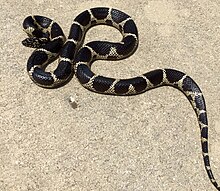Lampropeltis getula
| Eastern kingsnake | |
|---|---|

| |
| Scientific classification | |
| Domain: | Eukaryota |
| Kingdom: | Animalia |
| Phylum: | Chordata |
| Class: | Reptilia |
| Order: | Squamata |
| Suborder: | Serpentes |
| Family: | Colubridae |
| Genus: | Lampropeltis |
| Species: | L. getula
|
| Binomial name | |
| Lampropeltis getula (Linnaeus, 1766)
| |
| Synonyms[2] | |
| |
Lampropeltis getula, commonly known as the eastern kingsnake,[3] common kingsnake,[4] or chain kingsnake,[5] is a harmless colubrid species endemic to the United States and Mexico. It has long been a favorite among collectors.[5] Nine subspecies are currently recognized, including the nominate subspecies described here.[6]
Description[edit]


Adult specimens of the speckled kingsnake, L. g. holbrooki, are the smallest race at 91.5 cm (36.0 in) in snout-to-vent length (SVL) on average, while L. g. getula is the largest at 107 cm (42 in) SVL on average.[7] Specimens up to 208.2 cm (82.0 in) in total length (including tail) have been recorded.[8] Weight can vary from 285 g (10.1 oz) in a small specimen of 87.2 cm (34.3 in) in total length, to 2,268 g (80.0 oz) in large specimens, of over 153 cm (60 in) in total length.[7][9]
The color pattern consists of a glossy black, blue black, or dark brown ground color, overlaid with a series of 23-52 white chain-like rings.[5][10] Kingsnakes from the coastal plains have wider bands, while those found in mountainous areas have thinner bands or may be completely black.[citation needed]
Common names[edit]
Common names for L. getula include eastern kingsnake,[3] common kingsnake,[4] chain kingsnake,[5] kingsnake, Carolina kingsnake, chain snake, bastard horn snake, black kingsnake, black moccasin, common chain snake, cow sucker, horse racer, master snake, North American kingsnake, oakleaf rattler, pied snake, pine snake, racer, rattlesnake pilot, thunder-and-lightning snake, thunderbolt, thunder snake, wamper, wampum snake.[10]
Geographic range[edit]
L. getula is found in the United States in Alabama, Arizona, Arkansas, California, portions of Colorado, Delaware, Florida, Georgia, south and southwest Illinois, southern Indiana, southern Iowa, Kansas, Kentucky, Louisiana, Maryland, Mississippi, Missouri, Nebraska, southern and western Nevada, New Jersey, New Mexico, New York, North Carolina, southern Ohio, Oklahoma, southern Oregon, South Carolina, Tennessee, Texas, southern Utah, Virginia, and West Virginia. It is also found in northern Mexico, including all of Baja California.[2] It has been introduced to Gran Canaria in the Canary Islands, where in 2014, the population had reached an estimated 20,000 individuals.[11]
Habitat[edit]
The preferred habitats of L. getula are open areas, particularly grassland, but also chaparral, oak woodland, abandoned farms, desert, low mountains, sand, and any type of riparian zone, including swamps, canals, and streams. A study on the habitat use of the Eastern Kingsnake found that overall they prefer and can be found in sites with thick layer of leaf litter and dense shrubbery. From their observations throughout the course of research, they found that 79% of their tracked specimen spent the majority of their time concealed under the cover of soil and leaf litter.[12]
Although commonly described as diurnal, some reports suggest that the Eastern Kingsnake are crepuscular or nocturnal during the hottest parts of the year.[13] They will often retreat into rodent burrows as nocturnal retreats.[14]
It has been found that Eastern Kingsnake home ranges often show little-to-no overlap.[15]
Some studies show that Eastern Kingsnakes (L. g. getula), especially males, are territorial, and will engage invading snakes in combat if their territory is threatened.[15]
Diet[edit]
L. getula eats other snakes, including venomous snakes such as copperheads (Agkistrodon contortrix), which are responsible for more venomous snakebites than any other in the United States, as well as coral snakes (Micruroides and Micrurus), massasaugas (Sistrurus catenatus), and other rattlesnakes (Crotalus and Sistrurus).[16] Among the non-venomous snakes preyed upon include common garter snakes (Thamnophis sirtalis), common watersnakes (Nerodia sipedon), ring-necked snakes (Diadophis punctatus), smooth earth snakes (Virginia valeriae), and worm snakes (Carphophis amoenus).[16]
It has developed a hunting technique to avoid being bitten by clamping down on the jaws of the venomous prey,[citation needed] but even if envenomated, it is immune. It also eats amphibians, turtle eggs, bird eggs (including those of the northern bobwhite [Colinus virginianus]),[16] lizards (such as five-lined skinks [Plestiodon fasciatus]),[16] and small mammals (such as white-footed mice [Peromyscus leucopus]),[16] which it kills by constriction.[17]
Due to their diet of eating other snake species, kingsnakes are a key factor in the spread of ophidiomycosis. This is a relatively new snake fungal disease originating from the fungus, Ophidiomyces ophiodiicola. This disease has a variety of impacts on snakes and the extent of this impact is still being researched.[18]
Reproduction[edit]
L. getula is oviparous. Adult females lay up to several dozen eggs that hatch after 2.0-2.5 months of incubation. Hatchlings are brightly colored and feed on small snakes, lizards, and rodents.[5] Eastern Kingsnakes (L. g. getula) are active from April–October in most parts of their habitat range and breeding occurs in the spring months.[19] Neck-biting is a common behavior when mating.[20]
In captivity[edit]
Long a favorite among collectors, L. getula does well in captivity, living to 25 years or more. Some of the most popular subspecies of the common kingsnake kept in captivity are the California, Brooks', Florida, and Mexican black kingsnakes.[5]
Subspecies[edit]
| Subspecies[6] | Authority[6] | Common name[6] | range |
|---|---|---|---|
| L. g. brooksi | Barbour, 1919 | Brooks's kingsnake | |
| L. g. floridana | Blanchard, 1919 | Florida kingsnake | |
| L. g. getula | (Linnaeus, 1766) | eastern kingsnake | |
| L. g. nigrita | Zweifel & Norris, 1955 | Mexican black kingsnake | |
| L. g. meansi | Krysko & Judd, 2006 | Apalachicola Lowlands kingsnake | the Apalachicola Lowlands, Florida |
References[edit]
- ^ Hammerson, G.A. (2019). "Lampropeltis getula". IUCN Red List of Threatened Species. 2019: e.T67662588A67662645. doi:10.2305/IUCN.UK.2019-2.RLTS.T67662588A67662645.en. Retrieved November 19, 2021.
- ^ a b Lampropeltis getula at the Reptarium.cz Reptile Database. Accessed June 29, 2008 {{{year}}}.
- ^ a b Conant R (1975). A Field Guide to Reptiles and Amphibians of Eastern and Central North America, Second Edition. (First published in 1958). Boston: Houghton Mifflin Company. 429 pp + 48 plates. ISBN 0-395-19979-4 (hardcover), ISBN 0-395-19977-8 (paperback). (Lampropeltis getulus getulus, p. 202).
- ^ a b Behler JL, King FW (1979). The Audubon Society Field Guide to North American Reptiles and Amphibians. New York: Alfred A. Knopf. 743 pp. LCCCN 79-2217. ISBN 0-394-50824-6. (Lampropeltis getulus, pp. 618-620).
- ^ a b c d e f Mehrtens JM (1987). Living Snakes of the World in Color. New York: Sterling Publishers. 480 pp. ISBN 0-8069-6460-X.
- ^ a b c d "Lampropeltis getula". Integrated Taxonomic Information System. Retrieved June 29, 2008.
- ^ a b "Lampropeltis getula (Common Kingsnake)".
- ^ "Lampropeltis getula getula". www.flmnh.ufl.edu. Archived from the original on February 24, 2001.
- ^ "Archived copy" (PDF). Archived from the original (PDF) on July 14, 2014. Retrieved July 26, 2012.
{{cite web}}: CS1 maint: archived copy as title (link) - ^ a b Wright AH, Wright AA (1957). Handbook of Snakes of the United States and Canada. 2 volumes. Ithaca and London: Comstock Publishing Associates. (7th printing, 1985). 1,105 pp. ISBN 0-8014-0463-0. (Lampropeltis getulus getulus, pp. 372-376).
- ^ John Bowler (2018). Wildlife of Madeira and the Canary Islands. Wild Guides. p. 164. ISBN 9780691170763.
- ^ Wund, Matthew A.; Torocco, Michael E.; Zappalorti, Robert T.; Reinert, Howard K. (September 2007). "Activity Ranges and Habitat Use of Lampropeltis getula getula (Eastern Kingsnakes)". Northeastern Naturalist. 14 (3): 343–360. doi:10.1656/1092-6194(2007)14[343:ARAHUO]2.0.CO;2. ISSN 1092-6194. S2CID 84312480.
- ^ Howze, Jennifer & Smith, Lora. (2012). Factors Influencing Eastern Kingsnake Diel Activity. Copeia. 2012. 460-464. 10.2307/23273252.
- ^ Godley, J. Steve; Halstead, Brian J.; McDiarmid, Roy W. (December 1, 2017). "Ecology of the Eastern Kingsnake (Lampropeltis getula) at Rainey Slough, Florida: A Vanished Eden". Herpetological Monographs. 31 (1): 47. doi:10.1655/herpmonographs-d-16-00006.1. ISSN 0733-1347.
- ^ a b Steen, David A.; Smith, Lora L. (September 2009). "Eastern Kingsnake (Lampropeltis Getula Getula) Home Ranges Exhibit Limited Overlap". Southeastern Naturalist. 8 (3): 553–558. doi:10.1656/058.008.0316. ISSN 1528-7092. S2CID 85945120.
- ^ a b c d e "Lampropeltis getula (Common Kingsnake)". Animal Diversity Web.
- ^ Schmidt KP, Davis DD (1941). Field Book of Snakes of the United States and Canada. New York: G.P. Putnam's Sons. 365 pp. (Lampropeltis getulus, "Food", p. 176).
- ^ Davy, Christina M.; Shirose, Leonard; Campbell, Doug; Dillon, Rachel; McKenzie, Christina; Nemeth, Nicole; Braithwaite, Tony; Cai, Hugh; Degazio, Tarra; Dobbie, Tammy; Egan, Sean (2021). "Revisiting Ophidiomycosis (Snake Fungal Disease) After a Decade of Targeted Research". Frontiers in Veterinary Science. 8: 665805. doi:10.3389/fvets.2021.665805. ISSN 2297-1769. PMC 8200636. PMID 34136555.
- ^ Wund, Turocco, Zappalorti, & Reinert (2007). "Activity Ranges and Habitat Use of Lampropeltis getula getula (Eastern Kingsnakes)". Northeastern Naturalist. 14 (3): 343–360. doi:10.1656/1092-6194(2007)14[343:ARAHUO]2.0.CO;2. JSTOR 4499924. S2CID 84312480.
{{cite journal}}: CS1 maint: multiple names: authors list (link) - ^ Kleinginna, Paul R.; Seamens, Joe (January 1980). "Discrimination in the Eastern Kingsnake Lampropeltis Getulus Getulus". The Journal of General Psychology. 102 (1): 153–154. doi:10.1080/00221309.1980.9920974. ISSN 0022-1309.
Further reading[edit]
- Hubbs B (2009). Common Kingsnakes: A Natural History of Lampropeltis getula. Tempe, Arizona: Tricolor Books. 436 pp. ISBN 978-0975464113.
- Linnaeus C (1766). Systema naturæ per regna tria naturæ, secundum classes, ordines, genera, species, cum characteribus, differentiis, synonymis, locis. Tomus I. Editio Duodecima, Reformata. Stockholm: L. Salvius. 532 pp. (Coluber getulus, new species, p. 382). (in Latin).
- Powell R, Conant R, Collins JT (2016). Peterson Field Guide to Reptiles and Amphibians of Eastern and Central North America, Fourth Edition. Boston and New York: Houghton Mifflin Harcourt. xiv + 494 pp. ISBN 978-0-544-12997-9. (Lampropeltis getula, p. 379 + Plate 34).
- Smith HM, Brodie ED Jr (1982). Reptiles of North America: A Guide to Field Identification. New York: Golden Press. 240 pp. ISBN 0-307-13666-3 (paperback), ISBN 0-307-47009-1 (hardcover). (Lampropeltis getula, pp. 180–181).
- Stebbins RC (2003). A Field Guide to Western Reptiles and Amphibians, Third Edition. The Peterson Field Guide Series. Boston and New York: Houghton Mifflin Company. xiii + 533 pp. ISBN 978-0-395-98272-3. (Lampropeltis getula, pp. 364–366 + Plate 44 + Map 153).
External links[edit]
- Lampropeltis getula at the Reptarium.cz Reptile Database. Accessed July 14, 2008 {{{year}}}.
- Eastern Kingsnake at the Florida Museum of Natural History. Accessed June 29, 2008.

